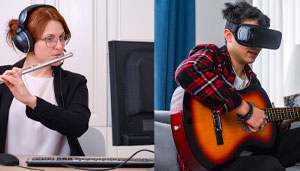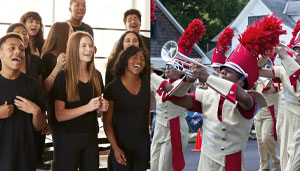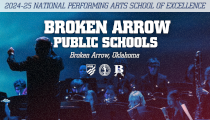More Bang for Their Buck: Teaching Students to Practice
By Dr. Nancy L. Summitt on December 16, 2019 music directors & adjudicators article Print
Music educators can often be heard exhorting their students to practice more often. Time spent practicing is essential, but the quality of practice is even more important than quantity (Duke, Simmons, & Cash, 2009; Willamon & Valentine, 2000). The use of a wide variety of effective practice strategies can facilitate students’ musical improvement. When music students articulate and understand how to use practice strategies, their musical achievement increases (Rohwer & Polk, 2006). This article will examine research-based instructional techniques for helping music students utilize practice strategies more effectively.
In order to practice effectively, students need to be able to demonstrate several different practice behaviors (Bonneville-Roussy & Bouffard, 2015; Byo & Cassidy, 2008; Duke, Simmons, & Cash, 2009; Lehmann & Ericksson, 1997; McPherson & McCormick, 1999). First, students should learn how to create optimal learning environments. Students will probably not be able to practice well in a room where a noisy video game is being played, for example. Second, setting specific and appropriate goals will help students determine how to improve their skills. “Play measures 8-16” is not very specific, whereas “increase dynamic contrast while maintaining good tone quality in measures 8-16” is more precise, giving the student a target to work toward. Next, students need to be able to identify mistakes, determine why they occurred, then use new strategies for correcting them. For example, a student might notice that the tempo is slowing down, but the cause could be difficult rhythms, softer dynamic levels, or another reason – each requiring a different solution. Once the cause of the mistake has been analyzed, the student should choose an appropriate strategy and practice until the mistake is corrected. This process involves self-evaluation, the ability to measure one’s performance against a standard and decide what elements still need to improve. The final effective practice behavior involves determining what resources would be most valuable to use when practicing and seeking them out. Examples of resources include information about the background of a piece, practice apps, metronomes, or recordings of excellent performances.
Since the effective use of practice strategies is vital to students’ musical improvement, music education researchers have been investigating what students do when they practice. Young instrumental music students tend to play straight through their music and ignore mistakes (McPherson & Renwick, 2001), a strategy that will not be useful for the more advanced music encountered in their future.Music students tend to focus first on correct pitches, then on correct rhythms, and then on intonation (Miksza, Prichard, & Sorbo, 2012). This may be a case of students working on “low-hanging fruit” first, or music students may be following a pattern observed in ensemble rehearsals. Miksza (2007) found that students most frequently repeated sections and marked their music – strategies which can often be observed in ensemble rehearsals. In another study, the practice strategies used by most of the students were those of repetition, marking the music, varying the tempo, and looking through the music before starting (Summitt, 2017). Rohwer (2002) found that writing down practice goals and recording and listening to the practice session were strategies that the students used least frequently. Students rarely plan out practice sessions in advance (Leon-Guerrero, 2008) or may use strategies inappropriately, lessening their effectiveness (Byo & Cassidy, 2008).
Practicing effectively is a skill that should be taught to music students. Music students tend to think that they are using more strategies than they actually do and do not always use the strategies they believe are most effective (Byo & Cassidy, 2008; Hallam, 2001a). Ensemble directors have a prime opportunity to help their students develop the use of practice strategies. Many rehearsal strategies work well as practice strategies; for example, slowing the tempo of a difficult section is effective for both ensembles and individuals. Modeling a wide variety of rehearsal strategies should increase the likelihood that students will use those strategies in their own practice sessions. Modeling can be particularly powerful when paired with direct instruction; directors could use a strategy and then draw students’ attention to how they might use it when practicing.
Since goal-setting is an important part of effective practicing, directors should explain to students how rehearsal goals are chosen. Choosing practice goals that are either too difficult or too easy will impact the effectiveness of students' practice as well as their motivation. The selection of which musical passages to rehearse often relates to need to rehearse particular musical elements in a piece (e.g., rhythm, melody, harmony) in relation to its form. Explaining this process teaches students to analyze their own pieces in order to prioritize particular practice tasks. Explanations of why certain strategies are used rather than others help students to find the most effective practice methods to solve musical problems. Then, allowing students to briefly put on the “director’s hat” through questioning or problem solving lets them analyze rehearsal strategies for themselves. Directors should ask students to evaluate the ensemble’s performance and then suggest tactics for working on observed problems. The ensemble could then decide what strategies seemed to work best and why.
Outside of rehearsals, music educators have many means of facilitating more effective practice behaviors. Frequent, small performances in chamber ensembles can motivate students to practice more often and intensely, particularly if it’s music they enjoy playing. Varying the types of musical opportunities offered to students can also be engaging; some students may enjoy improvisation, and would be more likely to practice if improvisation was part of their practice routine.
Practice assignments that focus on strategy use rather than time may encourage students to focus on the quality of their practice sessions instead of the clock. Teachers could ask students to try to use a certain number of different strategies in a practice session, for example, or to work on developing facility with a less commonly used strategy. Students have individual strengths and weaknesses, so tailoring practice assignments to their needs is very useful. One student might need help with maintaining a steady tempo and would then be assigned to work with a metronome, while another might need to work on rhythm reading through wind patterns or body movement.
With today’s technology, teachers can utilize guided practice sessions to help students learn how to practice. Students could video record practice sessions and their teacher would then be able to make comments on how effective the practice behaviors were. Students’ self-evaluation skills can be developed by asking them to assess how well they practiced and how they could improve. Assignments with clear, specific goals give students a target to aim for when they practice, which helps develop self-evaluation skills. Asking students to work on shortening the articulation during a certain section is more specific than asking them to “work on” that section, for example, and they will be better able to determine if that goal was met.
Performance rubrics are also helpful to students when they are being assessed, because rubrics provide information about different elements of musical performance. If students know that they need to work on tone quality more than note accuracy, they can structure practice sessions more effectively. Keeping reflective practice journals may also develop self-evaluation skills by enabling students to track areas of strength and weakness over longer periods of time. It can also be motivating to observe improvement over time, encouraging students to continue to practice effectively.
Beyond telling students about the importance of practice, music educators can show interest in their students’ practice. Asking students about how they practiced (rather than if they practiced) shows students that what they do is important, and it gives the teacher more information with which to make educational decisions. Students often come to music programs with maladaptive beliefs about what it is like to be a musician; they may think that “either you have it or you don’t.” Teachers can combat such beliefs by describing their own musical journey. When students experience growth in musicianship through deliberate practice, they will be more motivated to practice.
There are many different types of resources to help support students’ effective practicing. Providing access to recordings or live performances of excellent musicians helps students form an aural model of the sounds they should be striving for when practicing, which enables them to self-evaluate more accurately. Music practice apps, such as MyTractice or Modacity can help students track their practice sessions. Music educators may wish to create and share individualized practice logs through online word processors like Google Docs. Many students are visual learners and would benefit from having access to lists of available practice strategies. (See the list of strategies included with this article.) Ensemble directors could create and hang posters of practice strategies in rehearsal spaces for reference. Such lists would help students remember to try less commonly-used practice strategies when they encounter difficulties. Parents can be a powerful source of support, as well, but some parents may not know what is involved in effective practice. Teachers who clearly communicate appropriate expectations for practice sessions to parents empower them to be resources for music students struggling to develop practice skills.
Many music educators are motivated to help their students practice more effectively, as it is vital to the development of musical skills and ensemble achievement. Ineffective practice can be frustrating for students who believe they are putting in time and effort to accomplish little. However, it can be difficult to develop practice skills when students practice by themselves, with little to no supervision. The research literature on musical practice may inspire teachers to find more ways to teach students to use practice strategies to accomplish their musical goals.
References
Bonneville-Roussy, A., & Bouffard, T. (2015). When quantity is not enough: Disentangling the roles of practice time, self-regulation and deliberate practice in musical achievement. Psychology of Music, 43, 686-704.
Byo, J. L., & Cassidy, J. W. (2008). An exploratory study of time use in the practice of music majors self-report and observation analysis. Update: Applications of Research in Music Education, 27(1), 33-40. doi:/10.1177/8755123308322272
Duke, R. A., Simmons, A. L., & Cash, C. D. (2009). It's not how much, it's how: Characteristics of practice behavior and retention of performance skills. Journal of Research in Music Education, 56, 310-321.
Hallam, S. (2001a). The development of expertise in young musicians: Strategy use, knowledge acquisition and individual diversity. Music Education Research, 3, 7-23.
Kostka, M. J. (2002). Practice expectations and attitudes: A survey of college-level music teachers and students. Journal of Research in Music Education, 50, 145-154. doi:10.2307/3345818
Lehmann, A. C., & Ericsson, K. A. (1997). Research on expert performance and deliberate practice: Implications for the education of amateur musicians and music students. Psychomusicology: A Journal of Research in Music Cognition,16, 40-58. doi:10.1037/h0094068
Leon-Guerrero, A. (2008). Self-regulation strategies used by student musicians during music practice. Music Education Research, 10, 91-106. doi:10.1080/14613800701871439
McPherson, G. E., & McCormick, J. (1999). Motivational and self-regulated learning components of musical practice. Bulletin of the Council for Research in Music Education, 141, 98-102.
McPherson, G. E., & Renwick, J. M. (2001). A longitudinal study of self-regulation in children’s musical practice. Music Education Research, 3, 169-186.
Miksza, P. (2007). Effective practice: An investigation of observed practice behaviors, self-reported practice habits, and the performance achievement of high school wind players. Journal of Research in Music Education, 55, 359-375. doi:10.1177/0022429408317513
Miksza, P., Prichard, S., & Sorbo, D. (2012). An observational study of intermediate band students’ self- regulated practice behaviors. Journal of Research in Music Education, 60, 254-266. doi:10.1177/0022429412455201
Rohwer, D. (2002). Understanding practice: An investigation and applications. Music Education International, 1, 15-25.
Rohwer, D., & Polk, J. (2006). Practice behaviors of eighth-grade instrumental musicians. Journal of Research in Music Education, 54, 350-362. doi:10.2307/4139756
Smeltz, H. (2012). Reframing student practice to facilitate lifelong, joyful musicianship. Music Educators Journal, 99(2), 51-55. doi:10.1177/0027432112463248
Summitt, N. L. (2017). Influence of Self-Regulation and Motivational Beliefs on University Music Students' use of Practice Strategies (Doctoral dissertation). Retrieved from Proquest Dissertations and Theses Global. (Order No. 10669676).
Williamon, A., & Valentine, E. (2000). Quantity and quality of musical practice as predictors of performance quality. British Journal of Psychology, 91, 353-376. doi:10.1348/000712600161871
Dr. Nancy L. Summitt
Nancy Summitt received her B.M.E. from Arkansas Tech University, M.M. in Music Education from the University of Central Arkansas, and Ph.D. in Music Education from the University of Memphis. Before embarking upon her doctoral work, she taught K-12 music in Arkansas for seven years. Dr. Summitt is currently the Assistant Professor of Instrumental Music Education at DePauw University in Greencastle, Indiana. She has presented research at state, regional, and national music education conferences, and has been published in several music education journals.
This article first appeared in the Fall 2018 issue of INform Magazine.
Most Recent Articles







